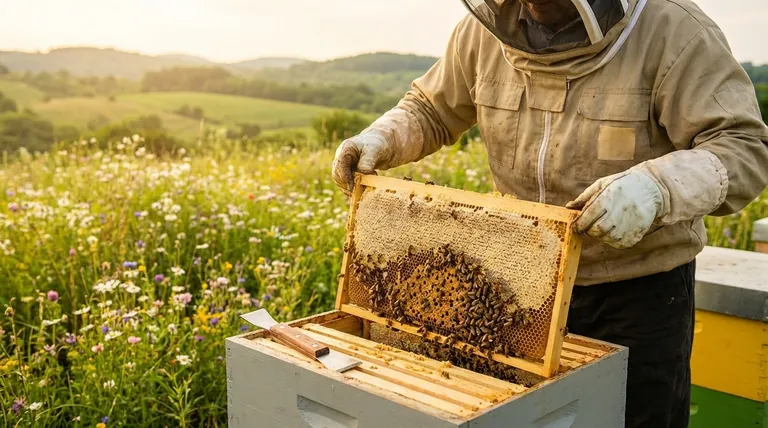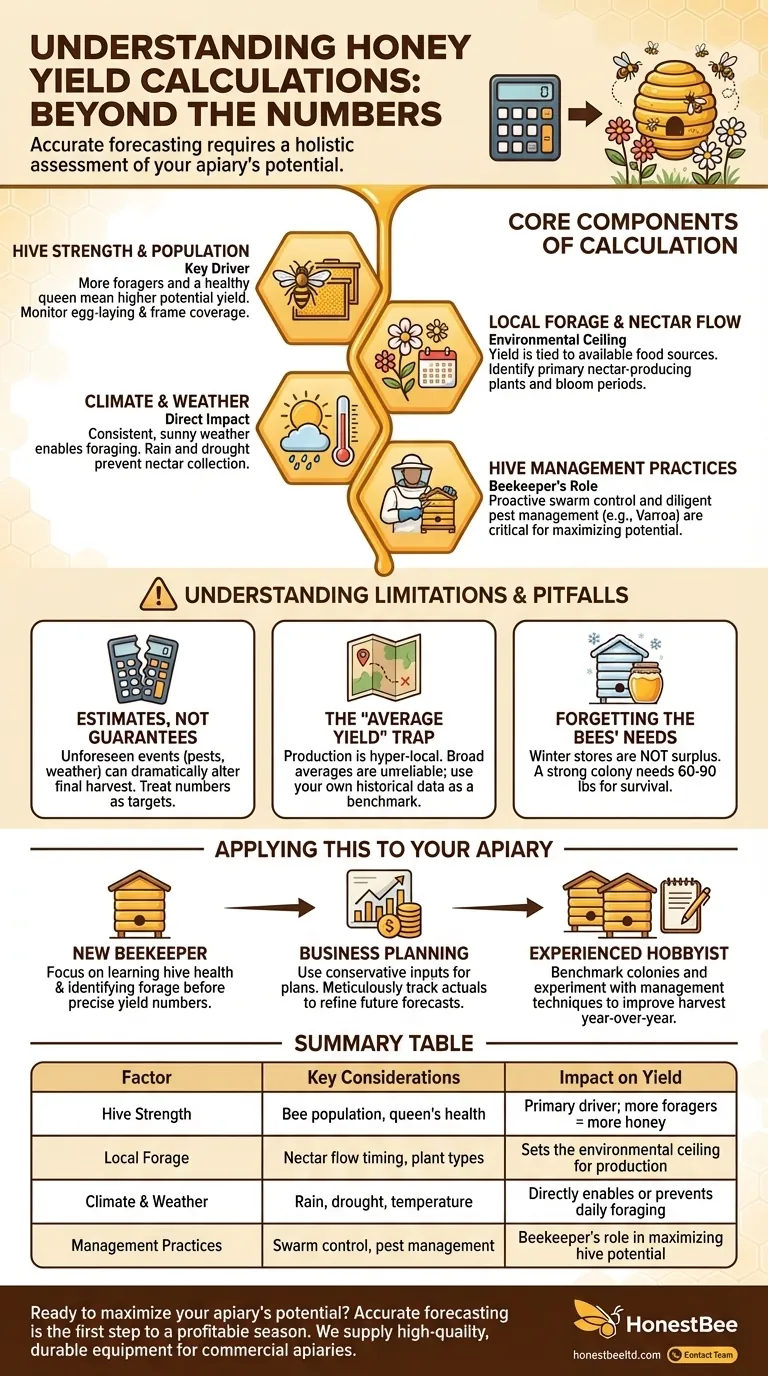To find details on honey yield calculations, your most immediate resource is a honey yield calculator. However, these tools are only the starting point. True understanding comes not from the calculator itself, but from accurately assessing the variables you input into it, which are rooted in hive health, environmental conditions, and your own management practices.
A honey yield calculator is a useful forecasting tool, but its output is only as reliable as your understanding of the real-world factors that dictate honey production. The calculation is less about a fixed formula and more about a holistic assessment of your apiary's potential.

The Core Components of a Honey Yield Calculation
Any calculator, whether it's a spreadsheet or a dedicated app, relies on the same set of fundamental inputs. Understanding these components is the key to creating a realistic forecast.
Hive Strength and Population
A colony's size is the primary engine of honey production. A larger population means more foragers are available to collect nectar.
Key metrics include the number of frames covered with bees and the queen's egg-laying pattern, which dictates the future workforce. A strong, healthy queen is foundational to a high yield.
Local Forage and Nectar Flow
Honey is concentrated nectar, so yield is directly tied to the available food sources. You cannot harvest more honey than the local environment can provide.
Beekeepers must identify the primary nectar-producing plants in their area and understand when they bloom. This period, known as the nectar flow or honey flow, is when the vast majority of surplus honey is produced.
Climate and Weather
Weather has a direct and immediate impact on foraging activity. Consistent, mild, and sunny weather is ideal for honey production.
Heavy rain prevents bees from flying, while prolonged drought can cause plants to stop producing nectar altogether. The length of your region's warm season also sets the ceiling for your potential yield.
Hive Management Practices
The beekeeper is a critical variable in the equation. Proactive management can significantly increase a hive's potential.
Effective swarm control keeps the workforce from splitting in half during the peak season. Diligent pest and disease management, particularly against Varroa mites, ensures the colony remains healthy and productive.
Understanding the Limitations and Pitfalls
While forecasting is valuable, it's crucial to recognize the inherent unpredictability of beekeeping. A calculation is an educated guess, not a guarantee.
Calculations are Estimates, Not Guarantees
Unforeseen events, like a sudden pest infestation, the loss of a queen, or an unseasonable weather pattern, can dramatically alter your final harvest. Treat any calculated number as a target, not a certainty.
The "Average Yield" Trap
Be wary of using broad regional or national averages. Honey production is hyper-local and can vary significantly from one yard to the next, even within the same town.
Your own historical data is always the most reliable benchmark for future calculations.
Forgetting the Bees' Needs
The most critical error in calculation is assuming all honey in the hive is for you. A strong colony requires a significant amount of honey—often 60 to 90 pounds—to survive the winter.
This winter store is not surplus. Your harvestable yield is only what the bees collect in excess of their own needs.
How to Apply This to Your Apiary
Your approach to yield calculation should match your goals. Use these principles to guide your planning.
- If you are a new beekeeper: Focus on learning to assess hive health and identifying local forage before concerning yourself with precise yield numbers.
- If you are planning a business: Use a calculator with conservative inputs for your business plan, and meticulously track your actual yields to refine future forecasts.
- If you are an experienced hobbyist: Use yield calculations to benchmark your colonies and experiment with how different management techniques impact your final harvest year-over-year.
Ultimately, a deep understanding of your bees and your environment is the most powerful honey yield calculator you will ever own.
Summary Table:
| Calculation Factor | Key Considerations | Impact on Yield |
|---|---|---|
| Hive Strength | Bee population, queen's health | Primary driver; more foragers = more honey |
| Local Forage | Nectar flow timing, plant types | Sets the environmental ceiling for production |
| Climate & Weather | Rain, drought, temperature | Directly enables or prevents daily foraging |
| Management Practices | Swarm control, pest management | Beekeeper's role in maximizing hive potential |
Ready to maximize your apiary's potential? Accurate forecasting is the first step to a profitable season. At HONESTBEE, we supply commercial apiaries and beekeeping equipment distributors with the high-quality, durable supplies needed to build and maintain strong, productive hives. From hive components to protective gear, our wholesale-focused operations ensure you get the reliable equipment your business depends on.
Let's discuss your needs and how we can support your success. Contact our team today for personalized service and wholesale pricing.
Visual Guide

Related Products
- Professional Dual-End Stainless Steel Hive Tool for Beekeeping
- Professional 3-Bar Frame Grip with Integrated Hive Tool
- All-Stainless Steel Pivoting Honey Uncapping Fork for Beekeeping
- Professional Multi-Function Stainless Steel Hive Tool
- HONESTBEE Professional Mini J-Hook Hive Tool for Beekeeping
People Also Ask
- What is a hive tool and what are its uses? Master Your Hive Inspections with the Essential Beekeeper's Tool
- What are the basic tools for beekeeping? Essential Starter Kit for Safe & Successful Hive Management
- What is a hive tool used for in beekeeping? Your Essential Guide to Hive Management
- What is the hive tool used for? The Essential Multi-Tool for Every Beekeeper
- What temperature is too cold to open a beehive? Protect Your Hive from Fatal Cold Shock



















